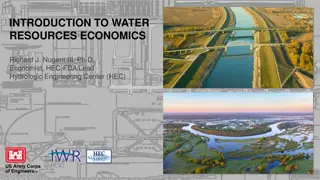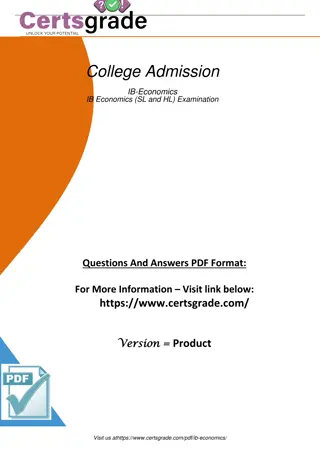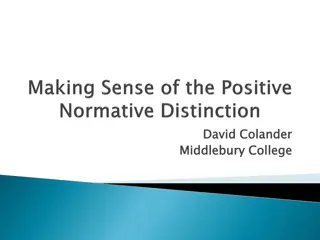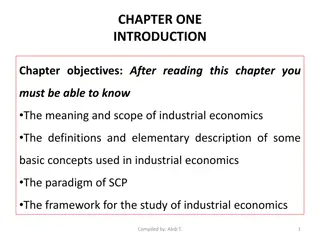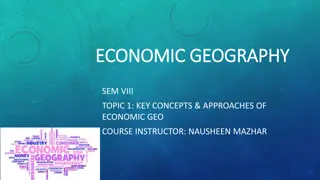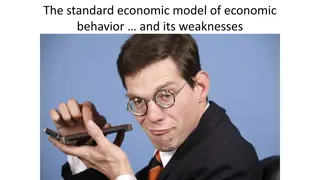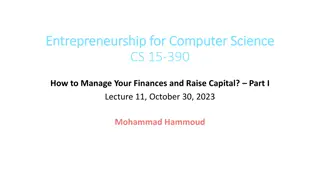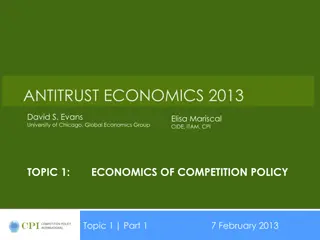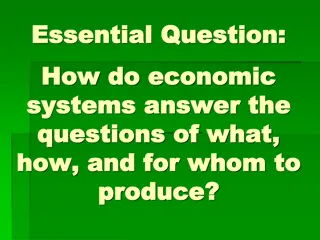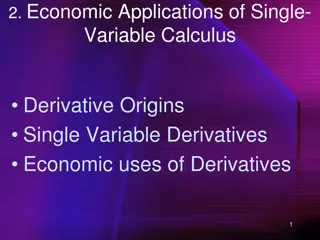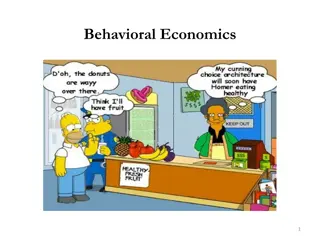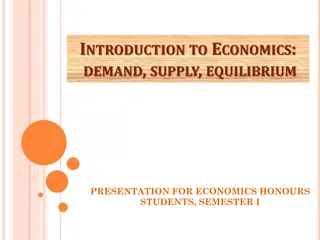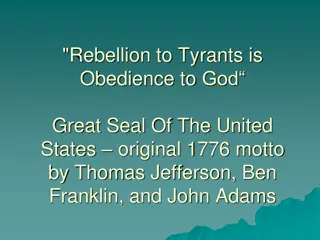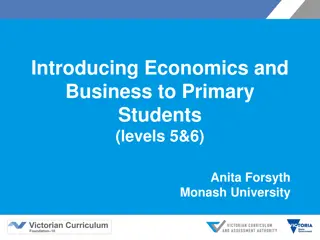Understanding Fundamental Economic Concepts: An Introduction to Economics
Explore key economic concepts such as scarcity, choice, needs vs. wants, economic products, and the impact of scarcity on society. Delve into how individuals make decisions when faced with limited resources, and consider the importance of time as a valuable economic resource. Reflect on the study of economics and its relevance in everyday life.
Download Presentation

Please find below an Image/Link to download the presentation.
The content on the website is provided AS IS for your information and personal use only. It may not be sold, licensed, or shared on other websites without obtaining consent from the author. Download presentation by click this link. If you encounter any issues during the download, it is possible that the publisher has removed the file from their server.
E N D
Presentation Transcript
honors Unit One Thinking Like an Economist
Activity Make a list of items you want - money is unlimited. Discuss these items
Cont.. Now how would your list change if you only had $100 Choice is a key concept in Economics Is time a resource - discuss
Chapter One What is Economics? The Study of how people try to satisfy what appears to be seemingly unlimited and competing wants through the careful use of relatively scarce resources.
Do you think the study of economics is worth your time and effort?
Scarcity and the Science of Economics Lesson 1 Go to page 6 and Complete the Scarcity activity.
What is the most fundamental economic problem facing all societies? SCARCITY The condition that results from society not having enough resources to produce all the things people would like to have.
Do you know the difference between a need and a want? Need is a basic requirement for survival food, clothing, shelter Want is a way of expressing a need example for food a person may want pizza
Economic Products goods and services that are useful, relatively scarce, and transferable to others. Good an item that is economically useful or satisfies an economic want -Durable and Nondurable goods
Adam Smith pg. 9 Read the article and answer the critical thinking questions. Turn in for a grade The father of Economics
Important Economic Terms Consumer Good use by individuals Capital Goods used to produce other goods Services work that is performed Consumers one who uses goods and services
Value refers to a worth that can be expressed in dollars and cents Paradox of Value - what makes something valuable? Utility the capacity to be useful and provide satisfaction Wealth accumulation of products
What is TINSTAAFL? THERE IS NO SUCH THING AS A FREE LUNCH Visual pg. 12 - discuss
Three Basic Questions What to produce? How to Produce? For Whom to Produce?
The Scope of Economics Description - Gross Domestic Product (GDP) - the monetary value of all final goods, services, and structures produced within a country s borders in a 12-month period Analysis Why? Explanation Prediction
Our Economic Choices Sec. 2
Money On a scale from 1 10 What kind of spender are you? 1 10 Scrooge Spender
Think of the economy as two broad groups: Producers and Consumers Complete activity on page 14
Factors of Production Land natural resources Capital tools, equipment, machinery and factories used in production (Capital Goods) (Financial Capital) Labor - workers Entrepreneurs risk takers Equals Production the process of producing goods and services
Production Possibilities Curve Identifying Possible Alternatives Fully Employed Resources Opportunity Cost the value of the next best alternative given up The Cost of Idle Resources Economic Growth
There are alternatives and costs to everything we do. In a world where TINSTAAFL , it pays to examine these concepts closely. TRADE OFFS or alternative choice figure 1.5 - discuss OPPORTUNITY COST the cost of the next best alternative use of the money, time, or resources when one choice is made rather than another
Opportunity Cost: Gerard has two choices for a summer job. The first is at a computer manufacturer, where he would earn $10.25 per hour. The second opportunity is with a landscaping company, where he could work and have lunch with three of his closest friends every day. The landscaping job would pay $8.65 per hour. For one 40-hour workweek, what would be the opportunity cost, in dollars, of accepting the landscaping job? What would be the opportunity cost of accepting the job with the computer manufacturer?
Consumer Rights The right to safety The right to be informed The right to choose The right to be heard The right to redress Consumerism - a social movement that aimed at promoting the interests of consumers
Consumer Responsibility Include important details and copies of receipt, guarantees, and contracts to support your case Report the problem immediately. Do not try to fix a product yourself, because doing so may cancel the warranty If you need to contact the manufacturer in writing, type the letter or send an e-mail. Keep a copy Cont.
Keep cool. The person who will help you solve your problem is probably not responsible for causing the problem Keep an accurate record of your efforts to get the problem solved. Include the names of people you have spoken to or written to and the dates on which you communicate Consumers are expected to do his or her research before purchasing a product Behave ethically when dealing with the producer or the merchant
Watch the Price system Key Words to listen for: Specialization of labor Voluntary exchange Free-Market economy Invisible hand Zero Sum game fallacy Supply and Demand Be prepared to answer questions about this video Turn in for a grade
Using Economic Models sec. 3 Because resources are scarce, consumers need to make wise choices.
Economic Growth When a nation s total output of goods and services increase over time 1. Economics growth requires risks and sacrifices.
Economic Growth 2. Economist can describe economic growth in a number of ways but the Production Possibility Curve (frontier) is the easiest
Economic Growth 3. Everyone benefits when resources are used efficiently (Increased Productivity) Productivity measure of the amount of output produced by a given amount of inputs in a specific period of time
Economic Growth 4. A major contribution to productivity comes from Human Capital Review chart on pg. 23
Economic Growth 5. Division of Labor and Specialization Division of Labor workers are arranged so that individual workers do fewer task Specialization when a worker does one task and does it well 6. Economic Interdependence
The Circular Flow of Economic Activity Factor Market the market where productive resources are bought and sold Product Markets market where producers sell their goods and services to consumers
Economic Interdependence We rely on others, and others rely on us to provide the goods and services that we consume
Thinking Like an Economist Build Simple Models Employ Cost-Benefit Analysis compare the cost of an action to the benefits received Take Small, Incremental Steps
Attend College State College Out-of-State College Cost Cost - Benefits Benefits -
The Road Ahead Understanding the FREE ENTERPRISE ECONOMY- one in which consumers and privately owned business, rather than the government, make the majority of the WHAT, HOW, & FOR WHOM decisions STANDARD OF LIVING the quality of life based on the possession of necessities and luxuries that make life easier Economics for Citizenship Making the Rational Choice
Brain storm with your neighbor how scarcity affects your school community and think about how the administration might deal with it. Make notes to use while writing your essay.
Write an essay in which you formulate some ideas about how the school administration could deal with that scarcity. Must have an Introduction, Body and Closing paragraph Turn in for a grade Rubric: *Do you have a Introduction, Body and Closing paragraph? 15 points *Address at least three problems and how the administration will deal with each problem 30 points *Neatness, grammar and spelling 10 Total points 55 Complete for homework
Review Activity Turn in for a grade Complete questions on page 33, # 1 8, 13, 14, & 15





